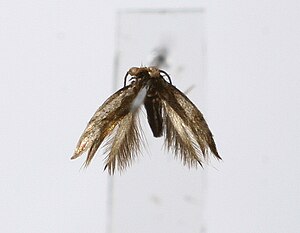Dwarf miners
| Dwarf miners | ||||||||||
|---|---|---|---|---|---|---|---|---|---|---|

Stigmella alnetella |
||||||||||
| Systematics | ||||||||||
|
||||||||||
| Scientific name | ||||||||||
| Nepticulidae | ||||||||||
| Stainton , 1854 |
The dwarf miners (Nepticulidae) are a family of butterflies (Lepidoptera). They occur worldwide with around 700 species in 28 genera . In Europe, 242 species and subspecies have been described so far, of which in Central Europe 135 species occur.
features
The moths have a wingspan of just three to ten millimeters, making them one of the smallest butterfly species in the world. They have a narrow, elongated body, which is hairy protruding. Their forewings are narrow and about three to four times longer than they are wide and mostly colored with a metallic sheen or provided with metallic patterns. The basic color is usually bronze or brass. However, some species do not have a metallic color. The hind wings are narrow, elongated and pointed. They are much narrower to about the same width as the front wings and have long fringes. The head is covered with hairy scales . The thread-like antennae are short to medium in length and reach about 0.5 to 0.75 times the length of the forewings. Your first limb ( scapus ) is widened at the base. Your five-membered Maxillarpalpen are well developed, proboscis the animals have not.
The wing veining of both pairs of wings is largely identical. The forewings have a strongly reduced vein with 5 to 8 veins and probably no anal veins. The hind wings have a well-developed vein, in some species it consists of six to seven veins.
Way of life and development
The larvae of the dwarf miners mine in leaves, seeds and bark and are usually specialized in a particular plant. Some species form plant galls .
The females usually lay their eggs on the underside of the leaves of the host plants. The larvae that hatch from it eat their way into the leaf and create a long passage between the upper and lower outer surface of the leaf ( cuticle ). The larvae of many species often only need a few days for their development. This allows them to produce several generations per year. The pupation takes place outside the mine in a cocoon place from which the animals push out a bit just before hatching.
Subfamilies
swell
Individual evidence
- ↑ Nepticulidae. Fauna Europaea, accessed January 4, 2007 .
- ↑ Nepticulidae. Lepiforum eV, accessed on January 4, 2007 .
- ^ Karl Eckstein, Die Kleinschmetterlinge Deutschlands , Stuttgart 1933
Web links
- Fam.Nepticulidae dwarf moths ( Memento from July 4, 2008 in the Internet Archive )
- British Insects: the Families of Lepidoptera